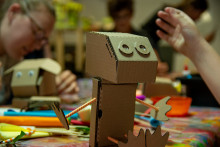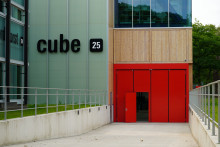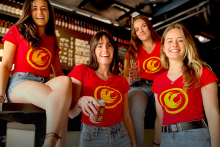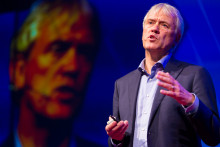The first seed for Maatje was planted during an course of Industrial Design Engineering assistant professor Deǧer Özkaramanlı, earlier this year. ‘Every year I challenge students to come up with a different concept. This year, we focused on open-ended children’s play,’ she says. ‘It started when I was shopping for Christmas presents for my nieces and nephews and – to my disappointment – I only found toys that reinforced gender stereotypes: blue cars for boys, pink dolls for girls… From our research we know that the toys children play with influence their future choices: play with cars and you want to become an engineer. Play with a doll and you want to become a mother.’
Using imagination
Özkaramanlı therefore challenged her students to come up with concepts for gender-neutral and open-ended toys. ‘Children see play potential in anything they encounter; even the patterns on a carpet can become roads or a mystical fantasy world in their imagination. I wanted students to use this imagination, while also using sustainable materials instead of the overused plastic fantastic materials we see in most toys.’
One of the best concepts came from the project group of Van Stralen and Wijnveen, who both decided to continue with it through a Capita Selecta (working on a topic based on a specific interest during a quartile), once the course ended. Özkaramanlı continued supervising them. ‘We still had what was very much a rough concept,’ explains Wijnveen. ‘We wanted to focus on children who are socially and emotionally less developed than their peers. So we went to a care farm (in Dutch: zorgboerderij, ed.), to create design opportunities with the children, that could really fit their needs. And it turned out what they really need, is a buddy.’
Birds and stars
And so, Maatje was born (the Dutch word for ‘buddy’). At a first evaluation, the students let children work with materials like toilet rolls and empty yoghurt cartons. They reworked that into a toolkit, filled with different cardboard boxes and shapes and materials to connect those. ‘Children can use this kit to build the buddy they want and best fits their needs,’ says Van Stralen. ‘So it could be a human-like puppet, a vehicle, an animal, a random object... It could go in any direction, even without directly being the buddy itself. For instance, there was a girl who created an object that would attract birds, because she loved interacting with animals.’
It’s examples like that, that show added benefits, says Van Stralen. ‘If you look at the entire process, you first let the children create their own buddy, which helps to create a bond. Once they’ve built their own buddy, the children present their results and caretakers can ask to reflect on what they built. This can help caretakers to gain a better understanding of the thoughts and feelings of the children. For example, one girl put glow in the dark stars on her Maatje. When asked why, she said it’s because she’s afraid of the dark.’

Research-led education
Although care farms show great interest in Maatje, the future of the open-ended and gender neutral toy is still unclear, says Wijnveen. ‘The concept has a lot of potential, but we’re not considering turning this into a start-up. Instead, we made this into an open source project, so there’s free access for others to further develop this concept. Some points still need improvement and we think there’s also a lot of potential for further research, in a graduation project for instance.’
Özkaramanlı agrees with her students. ‘They received a 9.5 for this project, which is a grade I rarely give. I think this project is a good example of research-led education; this is how we can create a win-win situation for both research and education. Open-ended and gender-neutral playing is a research line I’m working on and there’s still so much more to explore. I firmly believe this is the future of playing.’







